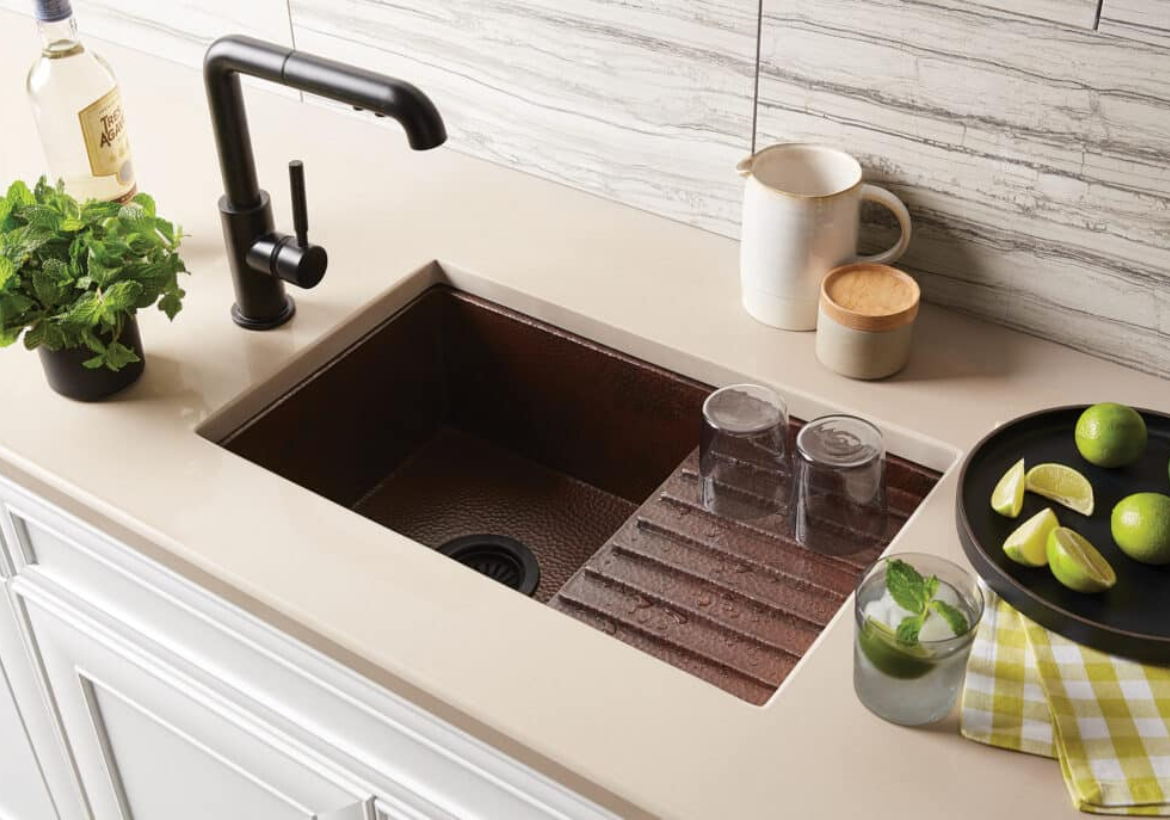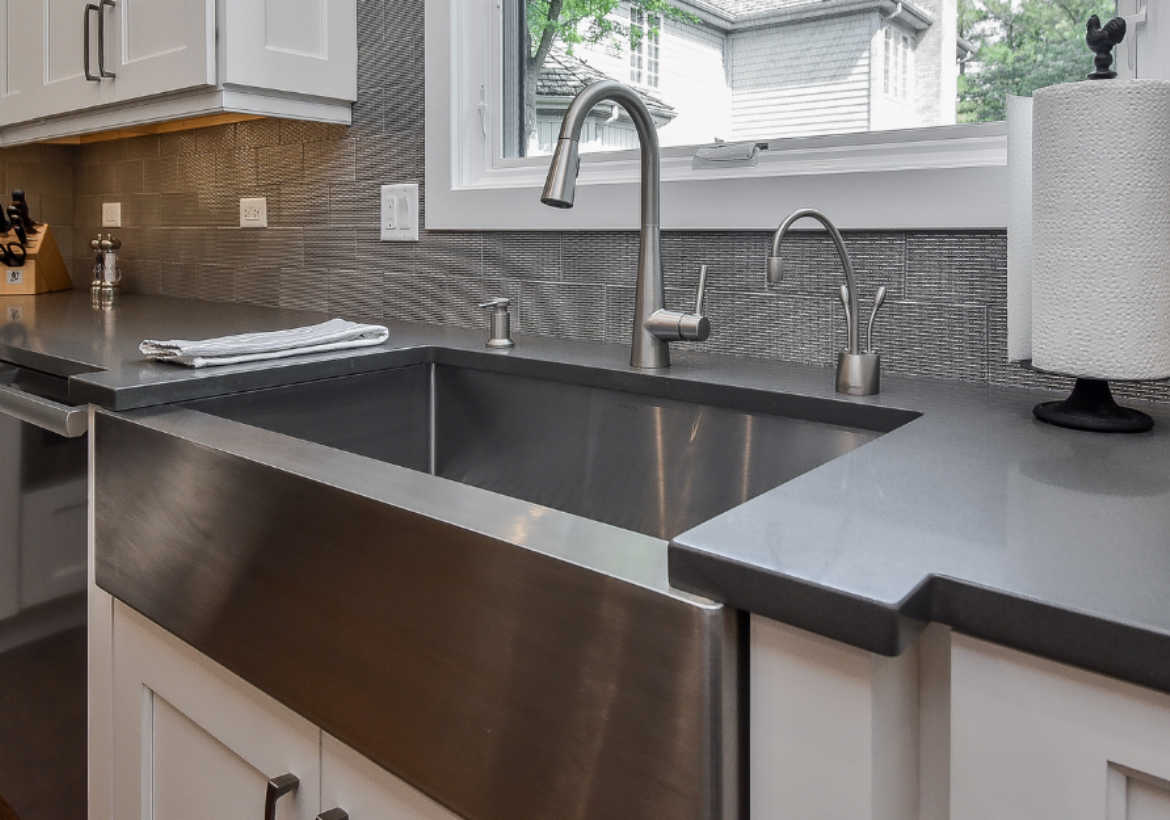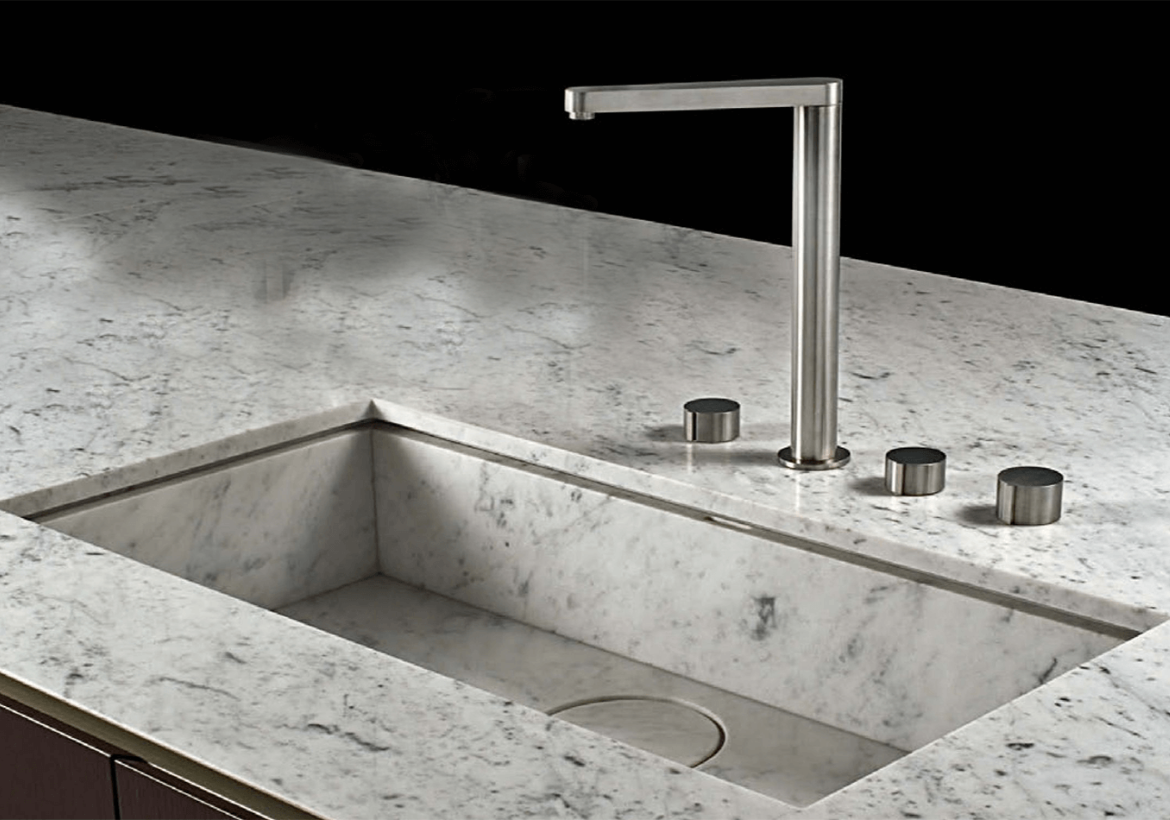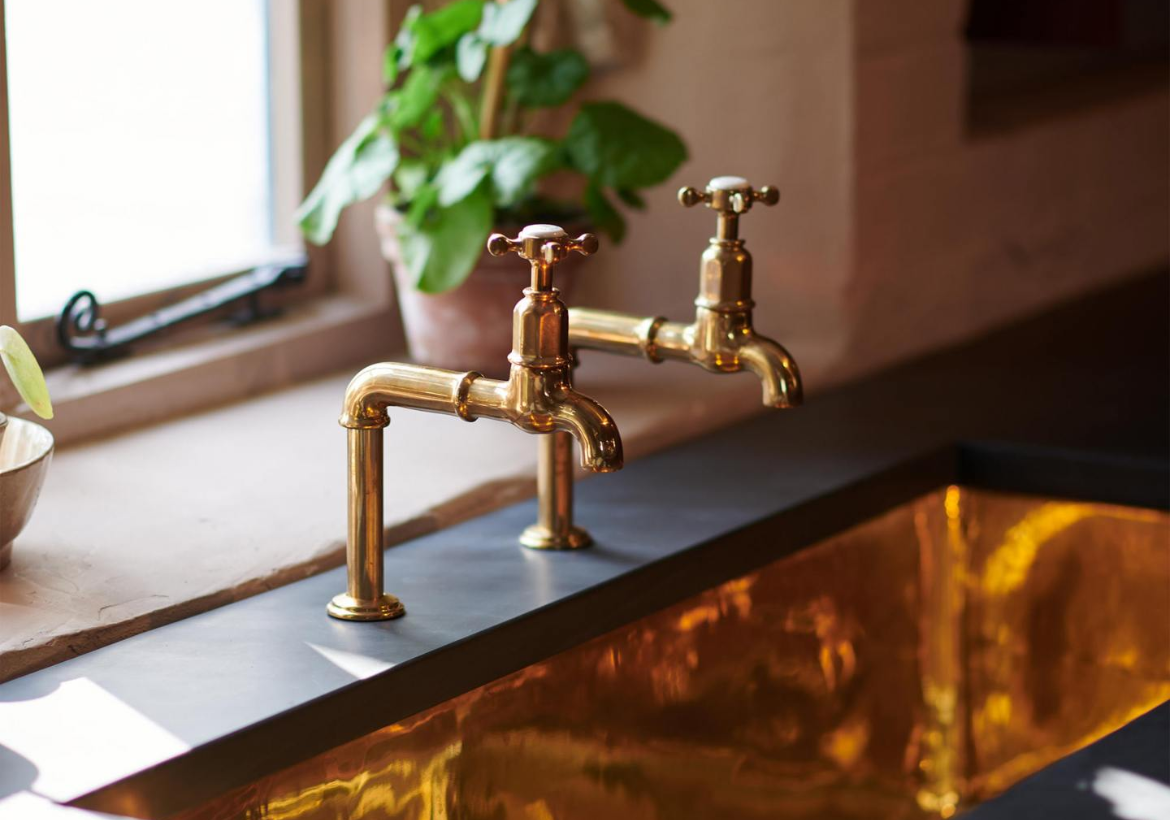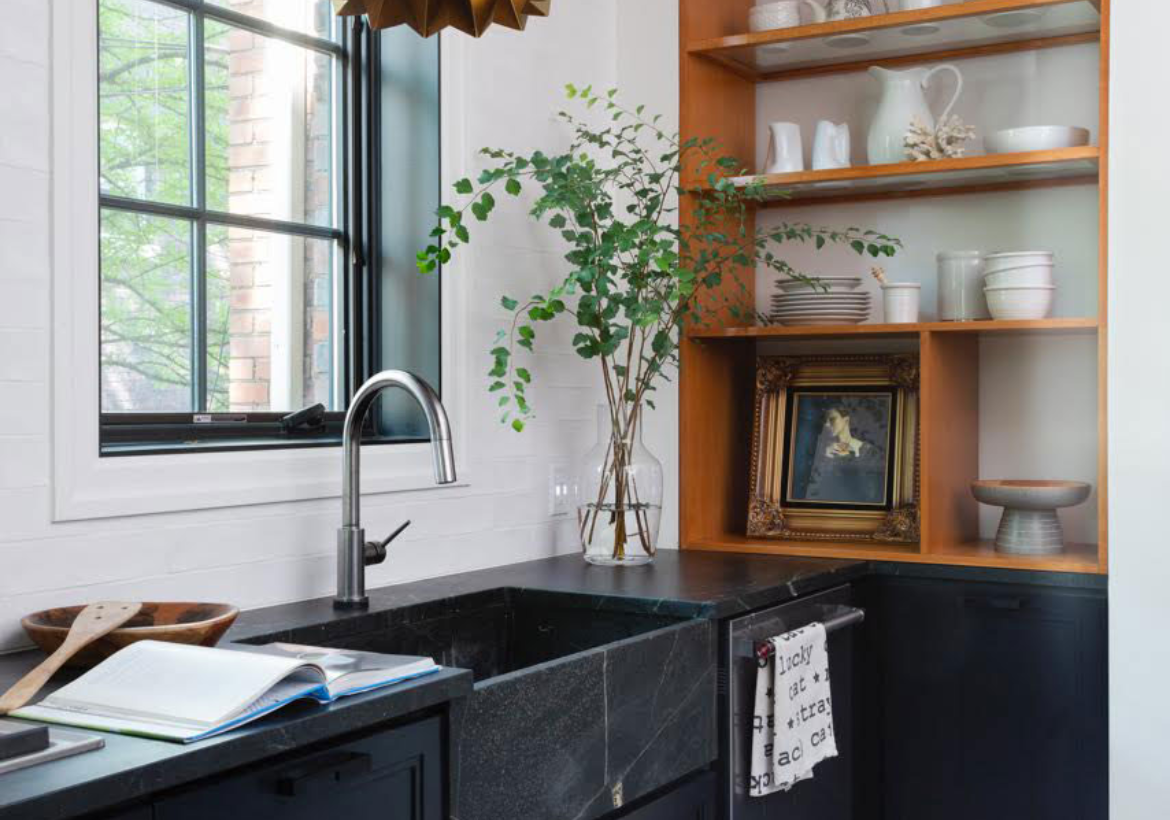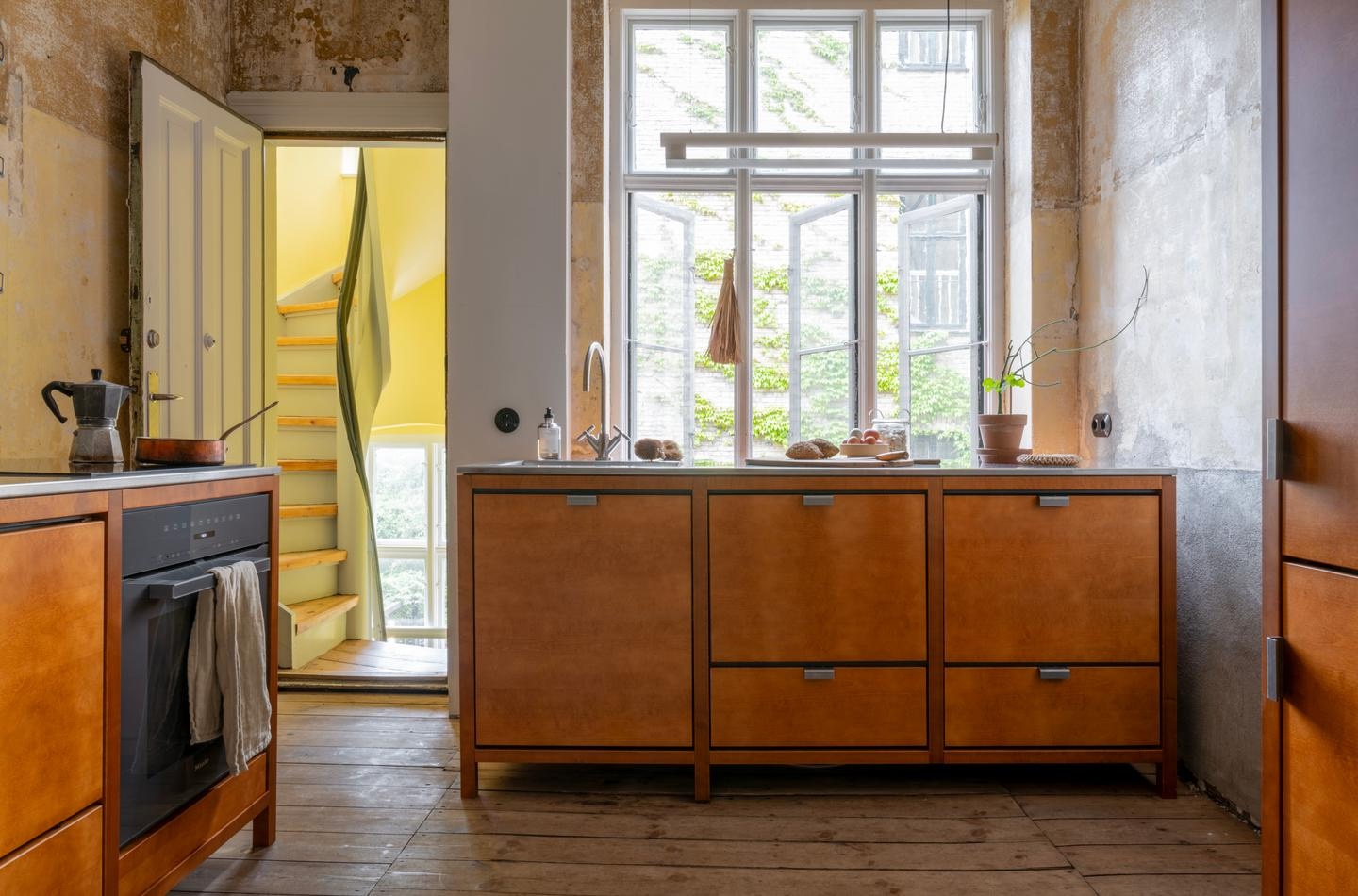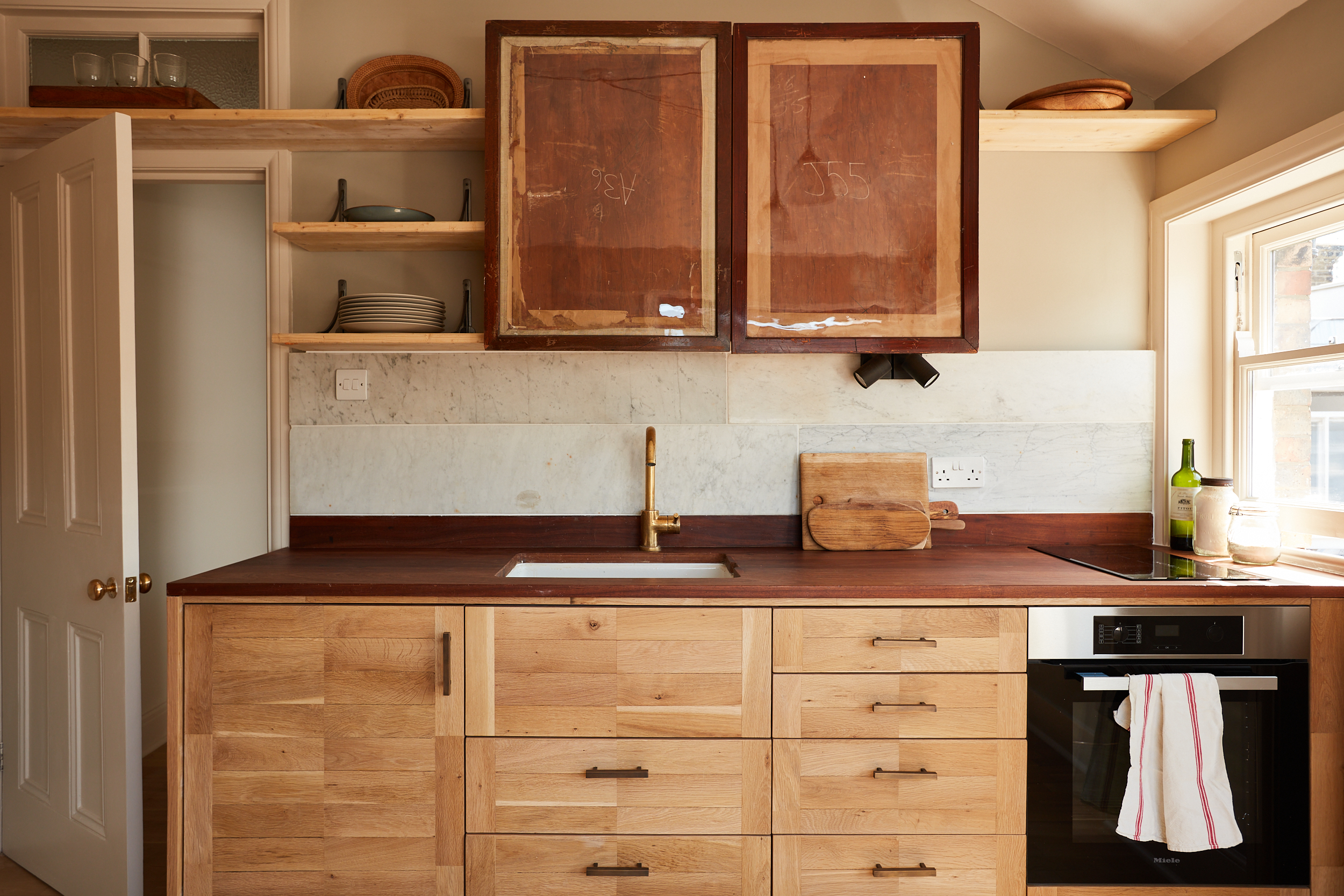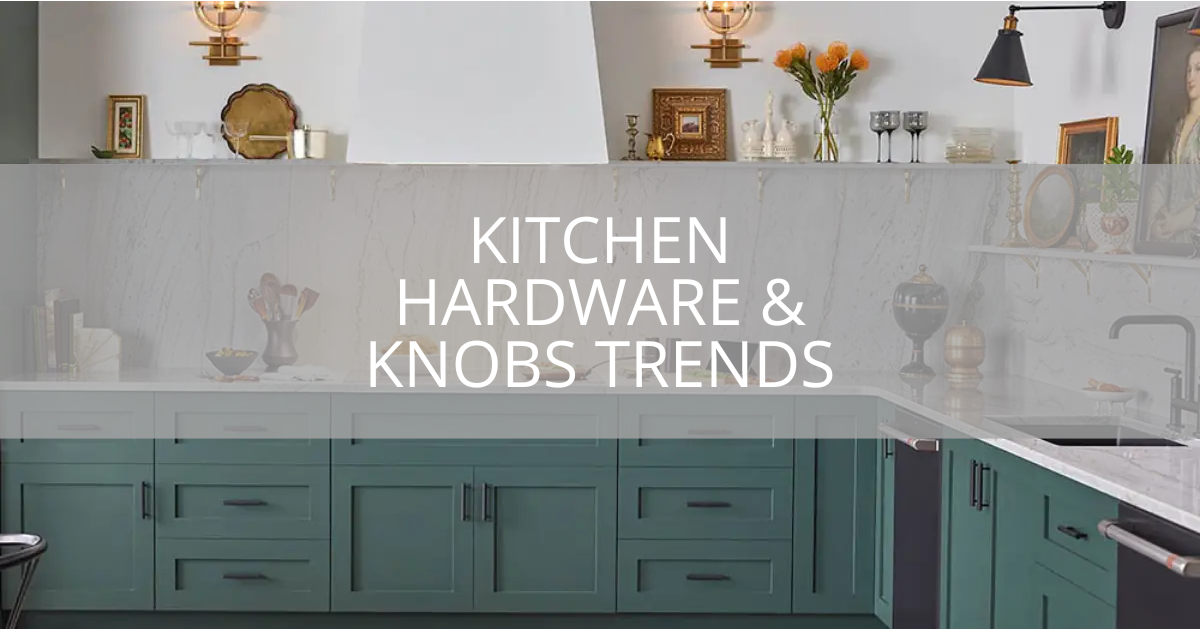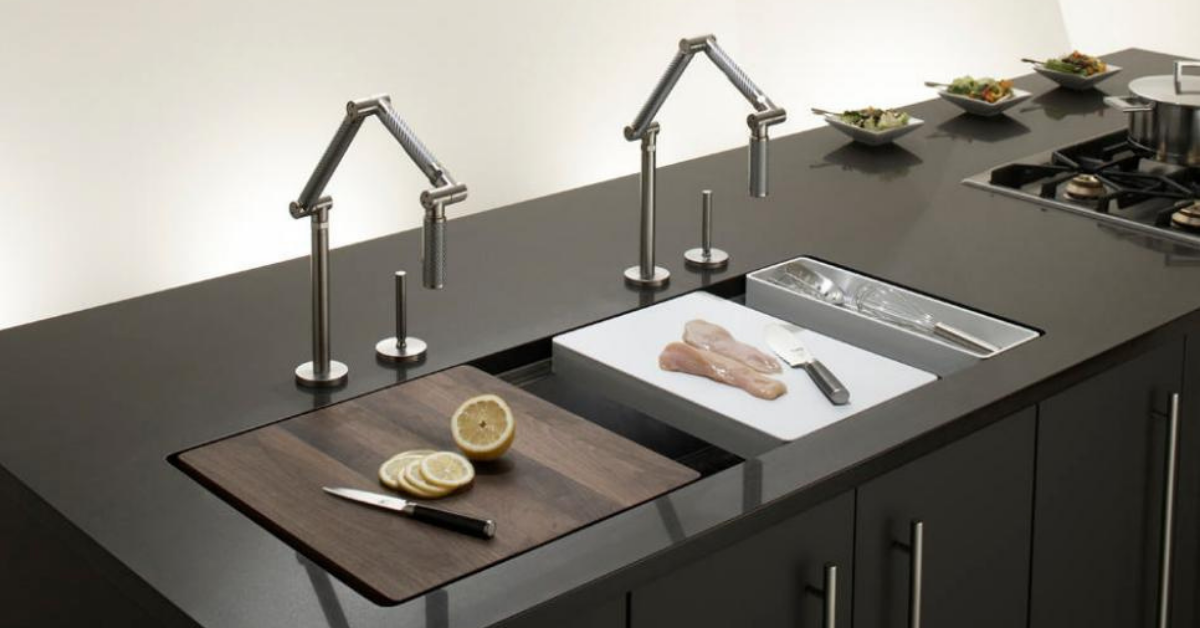
Featured Image: HGTV
The kitchen sink could be regarded as the kitchen’s focal point. It is, of course, one of the kitchen’s most frequently utilized features.
Cooking and cleaning can become more difficult if the sink is out-of-date or badly built. To ensure that your daily cooking activities flow smoothly, it is critical to select a sink type that is both functional and attractive. If you don’t know where to start, these kitchen sink ideas 2024 can help you.
So, how can you know which style is best for you? We have outlined five of the most popular kitchen sink trends for 2024.
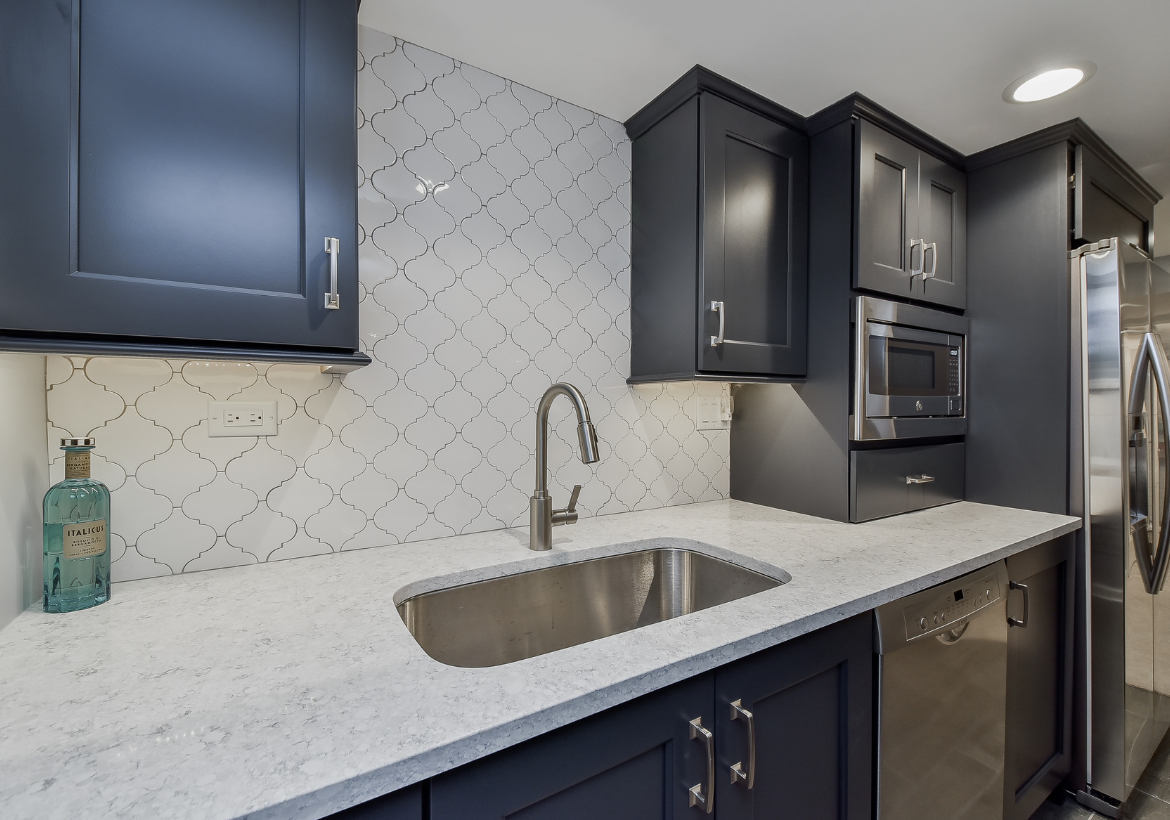
Sebring Design Build
Stainless steel kitchen sinks never go out of style!
1. Secondary Prep Sinks
These additional sinks, strategically placed apart from the primary sink, offer dedicated areas for meal preparation, dishwashing, and multitasking. With their proximity to secondary workstations or kitchen islands, these prep sinks facilitate efficient food preparation by allowing multiple users to work simultaneously without disrupting the primary sink’s use. Often equipped with their faucet and disposal system, secondary prep sinks streamline meal prep, cleanup, and cooking activities, making them an invaluable asset for busy kitchens and passionate home chefs.
The integration of secondary prep sinks redefines kitchen functionality, optimizing workflow, and versatility in the culinary space. These sinks cater to modern lifestyles by providing dedicated areas for specific tasks, promoting efficiency and organization during meal preparation and cleanup. Their inclusion in kitchen designs not only enhances functionality but also adds a level of convenience, ensuring smooth and efficient culinary experiences while maintaining the cleanliness and orderliness of the primary sink area.
Secondary prep sinks in the kitchen have become an increasingly sought-after feature, providing enhanced functionality and convenience in culinary spaces
2. Sinks In Countertop Material
These sinks, often crafted from the same material as the countertop itself, create a cohesive and visually striking appearance within the kitchen space. Using materials like granite, quartz, or solid surface materials, these integrated sinks eliminate the traditional boundaries between sink and countertop, offering a sleek and streamlined aesthetic. Besides their elegant appearance, these sinks present practical benefits as well, such as easier cleaning with no rim or edges to trap dirt, promoting hygiene while simplifying maintenance within the kitchen.
Sinks made from the same material as the countertop marks a harmonious union of form and function in modern kitchen design. This trend emphasizes a seamless, minimalist look, adding a touch of sophistication while streamlining the kitchen’s overall appearance. Beyond their aesthetic appeal, these integrated sinks contribute to a more hygienic and practical workspace, aligning with the desire for a clean, cohesive, and easy-to-maintain culinary environment.
Sinks integrated into countertop materials represent a seamless and sophisticated trend in kitchen design.
3. Workstation Sinks
These versatile sinks feature built-in accessories such as cutting boards, colanders, drying racks, and grids, transforming the sink into a multifunctional workstation. By integrating these accessories into the sink design, workstation sinks maximize utility and streamline meal prep and cleanup processes. They provide dedicated spaces for various kitchen tasks, allowing users to chop, wash, drain, and dry ingredients within the sink area, optimizing workflow and minimizing countertop clutter. With customizable accessories and configurations, these sinks cater to individual preferences, offering flexibility and convenience in culinary spaces.
Workstation sinks revolutionizes the traditional concept of kitchen sinks, offering a comprehensive solution for efficient food preparation and dishwashing. Their integrated accessories and thoughtful design elements enhance functionality, enabling users to perform multiple tasks conveniently within the sink area. Workstation sinks represent a fusion of practicality and innovation, providing homeowners with an organized and versatile workspace that elevates efficiency and enhances the overall functionality of the kitchen.
Workstation sinks are the pinnacle of efficiency and ingenuity in contemporary kitchen design.
4. Stone Sinks
Crafted from materials like granite, marble, or soapstone, these sinks offer a timeless elegance and durability that sets them apart. Their natural textures, unique veining patterns, and solid construction add a touch of sophistication and character to the kitchen. Stone sinks come in various shapes and sizes, offering homeowners an opportunity to infuse their culinary spaces with individuality and style. Beyond their aesthetic appeal, these sinks boast exceptional resilience, resisting scratches, stains, and heat, making them a practical and enduring choice for high-traffic kitchen areas.
The trend of kitchen sinks made of stone demonstrates a well-balanced combination of practicality and visual appeal. These sinks serve as striking focal points, elevating the overall design while providing a durable and long-lasting solution for daily kitchen activities. Their natural beauty and sturdy construction not only add a sense of luxury but also contribute to a sense of timelessness, making stone sinks a sought-after choice for homeowners looking to incorporate durability, style, and sophistication into their kitchen spaces.
Stone sinks are becoming a unique and opulent feature in contemporary kitchen design.
5. Copper Sinks
Known for their warm, rich tones and elegant appearance, copper sinks infuse kitchens with a touch of rustic charm and sophistication. Over time, copper develops a unique patina that enhances its character, evolving in color and texture, creating an ever-changing visual appeal. Beyond their aesthetic allure, copper sinks are highly durable and antimicrobial, possessing innate antibacterial properties that contribute to a cleaner and healthier kitchen environment. Their resilience against corrosion and heat makes them a practical and long-lasting option for daily kitchen use.
Copper sinks are a trend that combines style and utility to provide homeowners a distinctive and long-lasting addition to their kitchen areas. These sinks stand out as striking focal points, showcasing a distinctive and evolving aesthetic while providing a practical solution for daily culinary tasks. With their timeless appeal and inherent antimicrobial properties, copper sinks epitomize a blend of elegance, durability, and hygiene, making them a sought-after choice for those seeking a distinctive and enduring feature in their kitchens.
Copper sinks have gained popularity as a distinctive and stylish choice in contemporary kitchen design.
6. Dark Colored Sinks
Often crafted from materials like granite composite, fireclay, or stainless steel with dark finishes, these sinks offer a sleek and dramatic focal point in the kitchen. Their deep hues, such as matte black or dark charcoal, create a striking contrast against light-colored countertops, cabinetry, or backsplashes, adding a sense of depth and luxury to the space. Besides their aesthetic appeal, dark sinks effectively conceal stains and water spots, maintaining a cleaner appearance, and requiring less frequent cleaning compared to lighter options, while their durability and resilience make them a practical choice for everyday use.
Dark-colored sinks are becoming increasingly popular in kitchen designs, offering a sleek and modern aesthetic option. These sinks stand out as statement pieces, complementing various kitchen styles, from modern to industrial or transitional, and offering a versatile option for homeowners seeking a distinctive yet practical design element. Their ability to conceal blemishes, coupled with their striking appearance, makes dark-colored sinks an attractive choice, providing an eye-catching centerpiece while delivering functionality and resilience in the kitchen space.
As a bold and elegant style in modern kitchen designs, dark-colored sinks have become popular.
Kitchen Sink Trends: Factors To Consider
If you’re not starting from scratch, it’s likely that you’ll want to keep your new kitchen sink in the same spot as the recent one in order to save money on the expense of moving the plumbing and drains. Considerations such as how the sink is mounted and the best material, color, and kitchen sink design to match your newly renovated kitchen come into play even when replacing a sink in the same location. Here are some factors to consider as you navigate through kitchen sink trends.
Undermount Vs. Top-mount
When it’s time to replace your kitchen sink, there are a variety of mounting options to consider. “Top-mount” sinks, often known as drop-in sinks, and undermount sinks are the two most prevalent types of sink. It all relies on the sort of countertop you have and the type of sink material you select.
Top-mount sinks are often preferred because they are the most straightforward to install and can be used with any countertop material. As the name suggests, this sink is a drop-in kind that rests on top of a precut hole in the countertop. These sinks can also be called “self-rimming.” For added stability, some top-mount sinks have clips or screws. Because top-mount sinks are easier to install, they tend to cost less than undermount sinks.
In addition, an undermount sink describes a sink that is fitted beneath the counter. When using solid-surface countertops, such as granite, this eliminates the lip or rim on the top of the sink. With an undermount sink, countertop waste may be easily brushed into the sink, making cleanup a lot easier.
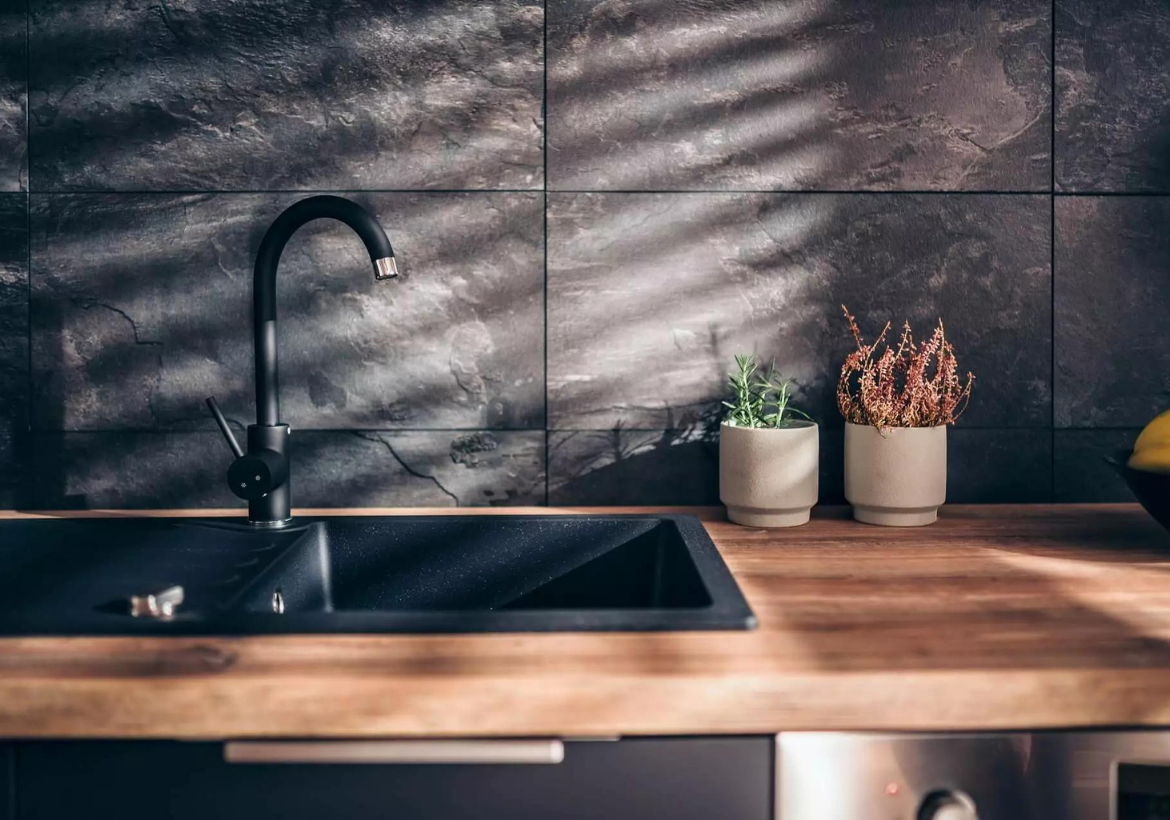
Hackrea
Modern and stylish hardware makes all the difference in the kitchen sink!
Style
However, there is no one-size-fits-all answer for kitchen sinks, which come in a variety of shapes and configurations. Kitchen sinks come in various sizes and shapes.
Two basins or bowls – One bowl is often used for soapy water, while the other is used to rinse dirty dishes. Another option is to use one bowl for soaking dirty pots and pans and the other for doing the usual washup. New advances in double-basin sinks include a double-bowl, low-divide sink, which has the benefit of two basins but can also fit pots with long handles.
Farmhouse/apron front – The farmhouse sink, also known as an apron-front sink, is a historic design that has seen a resurgence in recent years. It’s common for these to have a wide, deep single bowl, an open front, and an attached faucet. When it concerns cleaning large pots and pans, this approach is the best. Because of the sink’s size and construction, it can be more expensive than other types of sinks. A specific base or cabinetry modifications are required for a deep basin, which increases costs.
- Drainboard. Sinks with built-in drainboards, which allow you to prep veggies and let them drain without cluttering up the counter, are another classic that is once again becoming popular. It is also possible to use the drainboard to empty pots, pans, and kitchen utensils. There is only one drawback when it comes to adaptability: the drainboard takes up valuable counter space.
- Island/bar/prep. An island or bar sink is a tiny, additional sink that can be used to make drinks, prepare meals, or prevent cross-contamination of different types of food. Premium stainless steel is commonly used for these little supplementary sinks, which can be found either in a different part of the kitchen or in an entirely other room.
- Corner. Consider an L-shaped or rectangular form if your kitchen has room for a corner sink. Corner sinks allow for a more versatile counter arrangement and additional storage space under the sink.
- Workstation. “Workstation sink” refers to sinks with a variety of attachments that allow you to transform the sink area into food preparation and serving environment. Cutting boards, colanders, drying trays, warming racks, and other things enhance the sink area’s versatility without occupying additional counter space.
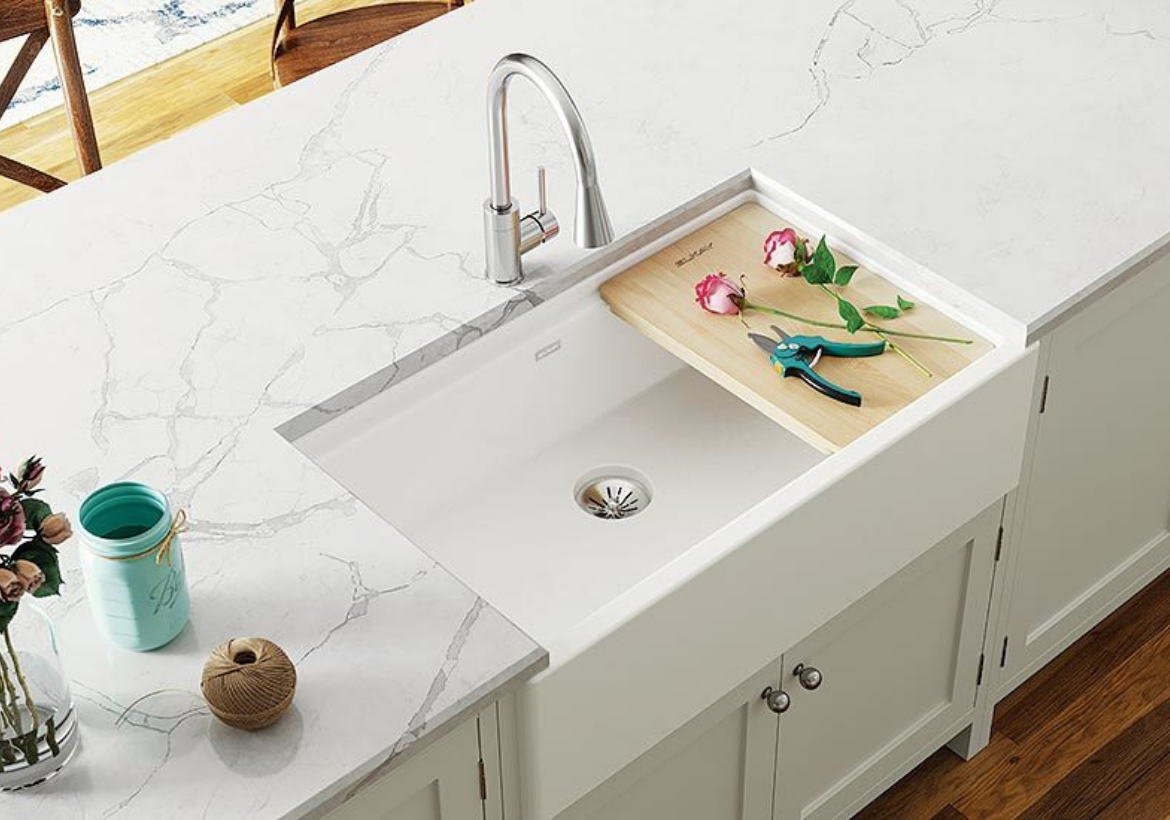
Plumbing & Mechanical
Cute and dainty sink for a lovely kitchen design.
Size
The size of a kitchen sink is typically a factor in determining the sink’s form and style. A kitchen remodel may be constrained by a lack of available space. There are three dimensions you need to take into account: length, known as side-to-side; width, known as front-to-back; and depth.
Kitchen sinks, whether single bowl or double bowl, can be as short as 22 inches or as long as 48 inches in the farmhouse design. Depending on the width of the supporting cabinetry, they might be anywhere from 24 inches wide to 32 inches wide. Bar sinks, also known as prep sinks, are typically 10 to 22 inches long by 8 to 10 inches wide, making them ideal for use on a kitchen island or nook.
A conventional kitchen sink depth ranges from 8 to 10 inches, but if you’re prepared to sacrifice under-sink storage space, you may choose a deeper sink that measures between 12 and 15 inches deep.
Material
Customers may now select from a wide range of materials for their kitchen sinks, as well as from a variety of prices. Many different materials can be utilized to create the desired look, from natural stone to man-made porcelain. Here are the most popular materials for kitchen sinks:
- Kitchen sinks made of stainless steel are the most common. Stainless steel is a low-cost, lightweight, long-lasting, and low-maintenance material that may be used in various interior design styles. The gauge of stainless steel is referred to as the thickness; the thinner the gauge, the more expensive the sink. Many various finishes are offered, including bright mirrors and lustrous satin appearances. Steel is a low-maintenance material, but the finish can get dull and damaged with time.
- Granite, quartz, and granite composite are quite popular, although natural granite sinks are the most expensive. Water spots can also be seen on mirror finishes. Due to the many minerals that make up granite and quartz, the stones have a beautiful, variegated appearance. The two materials are typically used together in kitchen sinks and countertops. It is possible to break, chip, or damage the stones if they are abused. In granite composite, which is typically 95 percent stone and 5 percent resin, the beauty of a genuine stone is combined with the strength of synthetic resin. The epoxy increases the sink’s hardness and durability, making it more resistant to dents, scratches, and cracks. In addition to being heavier than many other options, granite and granite composite sinks may necessitate specific installation.
Kitchen sinks were the norm, but cast iron covered in a thick enamel coating has fallen out of favor as other materials have become more fashionable. Enamel-coated cast iron is heavy, long-lasting, and easy to maintain. A wide range of colors is available for tinting the enamel. Enamels in lighter colors are more susceptible to staining than enamels in darker colors, but nonabrasive commercial stain remover is usually sufficient to remove stains. Typically, these materials have a more rustic look. They’re long-lasting and easy to maintain, but they’re also prone to chipping and hefty. Initially only seen in bathroom sinks, vitreous china is increasingly being used in both the kitchen and the bathroom.
A beautiful metal, copper, can be hammered or sculpted into many different designs, making it a charming accent to many different decorative styles. Health-conscious customers are increasingly turning to copper for its inherent antibacterial properties. Copper is a great option for a bar or island sink if you’re looking for something more affordable. To maintain its luster, copper necessitates more care and attention. Cleaning and waxing are necessary to retain the sheen of the material over time, as it will oxidize.
Acrylic, polyester, and fiberglass are examples of manufactured materials sometimes referred to as “solid surfaces.” To resemble natural stone, they are usually composed of resins or epoxy. It’s possible to rub out scratches on solid-surface sinks, particularly resistant to chipping and scratching. Although the materials are resistant to stains, they can be harmed by exposure to intense heat.
Concrete is a new material for kitchen sinks that offers many of the same benefits as granite but at a fraction of the cost. Because concrete may be poured on-site by contractors, sinks of any size or shape are possible. Precast options are also available to consumers. On the other hand, concrete is a weighty material that may necessitate custom cabinets. Staining is also an issue with this material.
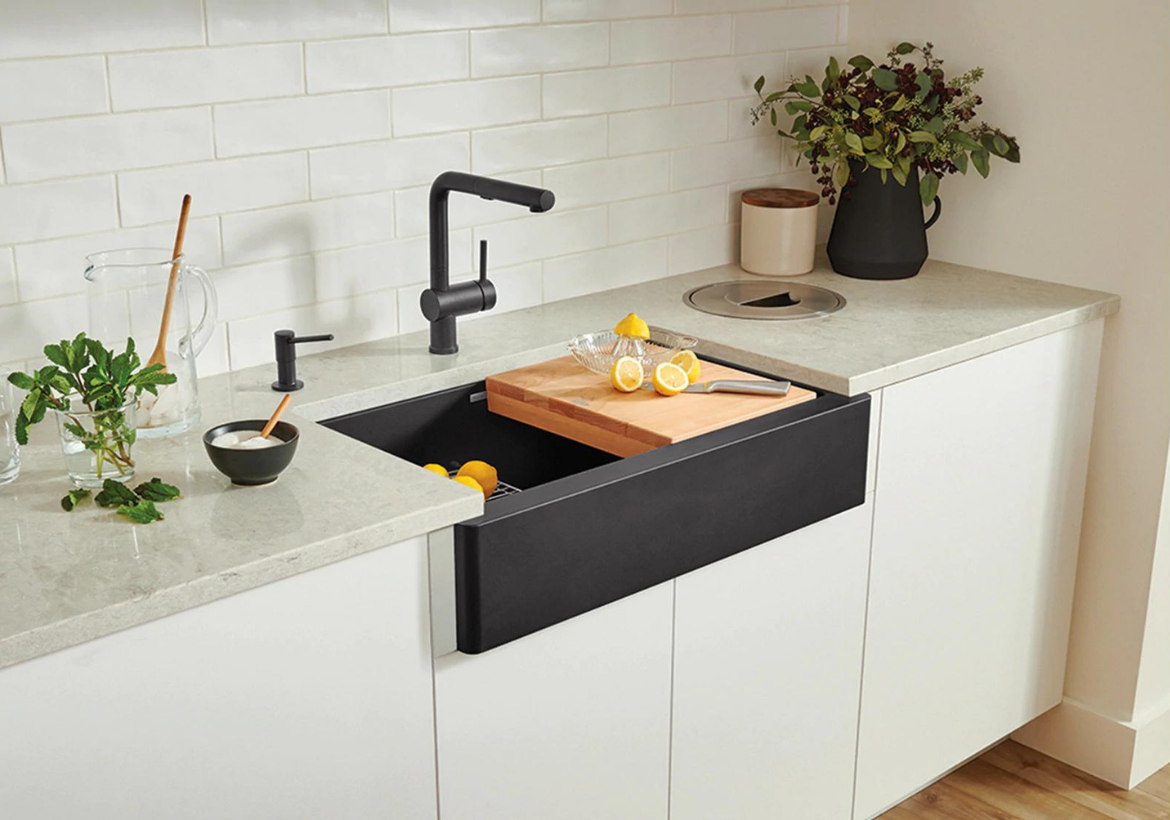
Uptown Kitchen Sinks
A jaw-dropping sink will instantly be a focal point!
Color
Stainless steel is the most popular color for kitchen sinks since it is the most popular material. Kitchen design is still dominated by stainless steel fixtures and appliances, although dark-colored natural stone finishes, such as granite and quartz, are becoming more popular.
The most popular colors for enamel-coated cast iron and fireclay or china sinks are white, off-white, beige, and sand because these neutrals go well with a wide range of décor styles. Darker colors like navy blue and black have been part of kitchen sink trends in recent years.
Installation
Kitchen sink shopping may be both enjoyable and scary because of the numerous installation factors that must be taken into account. The first thing to think about is the overall size of the object. If you’re replacing the sink in the same spot, you’ll need to take precise measurements of the existing opening. Whether you’re moving the sink or starting from scratch, the size of the kitchen will play a role in your decision on cabinetry and countertops.
Another consideration is the type of mounting holes for fixtures in a kitchen sink. Faucets, sprayers, and soap dispensers are often mounted using four holes in the sink. Some feature a separate drinking water faucet hole. Some sinks don’t have mounting holes. Thus, the faucets have to be wall-mounted.
We hope these kitchen sink trends will help you in your next kitchen remodeling project!


